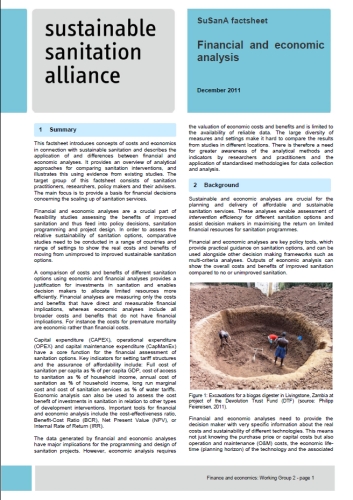Financial and economic analysis - Factsheet of Working Group 2
Parkinson, J., Hutton, G., Pfeiffer, V., Blume, S., Feiereisen, P. (2012)

Published in: 2012
Publisher:
Sustainable Sanitation Alliance (SuSanA)
Author:
Parkinson, J., Hutton, G., Pfeiffer, V., Blume, S., Feiereisen, P.
Uploaded by:
SuSanA secretariat
Partner profile:
common upload
10469 Views
367 Downloads
Content - Summary
This factsheet introduces financial and economic costs and benefits in relation to sanitation systems. It provides an overview of analytical approaches for comparing sanitation interventions using financial and economic analyses and illustrates these using results from various studies. The target group of this factsheet includes sanitation practitioners, researchers, policy makers and their advisers. The main focus is to provide a basis for informed choice based on financial decisions concerning the scaling up of sanitation services.
Financial and economic analyses are a crucial part of feasibility studies assessing the benefits of improved sanitation and thus feed into policy decisions, sanitation programming and project design. The data generated by financial and economic analyses have major implications for the programming and design of sanitation projects, and are therefore crucial for the planning and delivery of affordable and sustainable sanitation services.
In order to assess the relative sustainability of sanitation options, a range if comparative studies need to be conducted to show the real costs and benefits of moving from unimproved to improved and more sustainable sanitation options.
A comparison of costs and benefits of different sanitation options using economic and financial analyses provides a justification for investments in sanitation in the first instance and enables decision makers to allocate limited resources more efficiently. Financial analyses only measure the costs and benefits that have direct and measurable financial implications, whereas economic analyses include all broader costs and benefits, including those that do not have financial implications. For instance the costs for premature mortality are economic rather than financial.
Capital expenditure (CAPEX), operational expenditure (OPEX) and capital maintenance expenditure (CapManEx) are the key parameters for both the financial and economic assessment of sanitation options. Important tools for financial and economic analysis include the costeffectiveness ratio, Benefit-Cost Ratio (BCR), Net Present Value (NPV), or Internal Rate of Return (IRR). Key indicators for setting tariff structures and the assurance of affordability include: i) Full cost of sanitation per capita as a percentage of per capita GDP, ii) Cost of access to sanitation as a percentage of household income, iii) Annual cost of sanitation as a percentage of household income, iv) Long run marginal cost and cost of sanitation services as a percentage of water tariffs. Economic analysis can also be usedn to assess the cost benefit of investments in sanitation in relation to other types of development interventions.
Last updated: 30 April 2012
Bibliographic information
Parkinson, J., Hutton, G., Pfeiffer, V., Blume, S., Feiereisen, P. (2012). Financial and economic analysis - Factsheet of Working Group 2. Sustainable Sanitation Alliance (SuSanA)
Filter tags
English Factsheets and policy briefs Market development (WG2) Publications by SuSanA Publications by SuSanA















